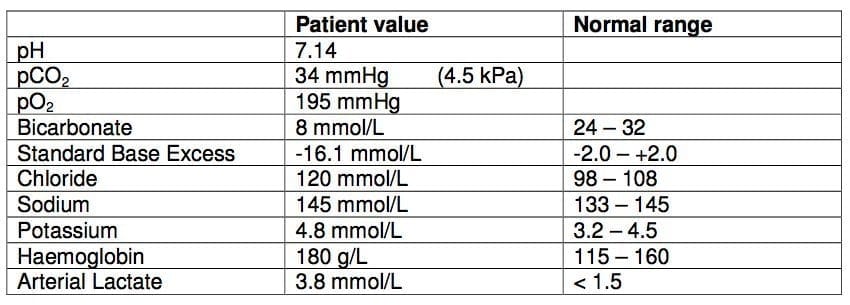CICM SAQ 2011.1 Q22
Questions
22. A 45 year old man was admitted to the intensive care unit after sustaining 40% BSA burns in a house fire. He was transported initially to a local hospital where initial resuscitation was commenced including mechanical ventilation for suspected inhalational injury. On arrival in your ICU an arterial blood gas was taken which is shown below:
- a) List four potential contributing causes of the metabolic derangement
- b) How would you classify the acid base derangement and explain your reasoning?
- c) The serum albumin is 18g/L. Outline how would this affect the anion gap.
- d) Whilst on your ward round the RMO asks your opinion on the Stewart approach to acid base physiology. List the 3 independent variables that comprise this approach
Answers
Answer and interpretation
a) List four potential contributing causes of the metabolic derangement
- Shock/Underesuscitation/hypovolaemia (elevated Hb and Lactate)
- Normal (0.9%) Saline fluid resuscitation
- Carbon monoxide poisoning
- Cyanide toxicity from smoke inhalation (elevated anion gap acidosis)
- Other missed injuries e.g. abdominal trauma, bleeding etc leading to hypoperfusion/shock
- Potential concurrent ingestions e.g. methanol, ethylene glycol
b) How would you classify the acid base derangement and explain your reasoning?
- Mixed metabolic acidosis (Note: CO2 is also high for pH but less relevant because patient on IPPV)
- Delta ratio indicates a greater fall in [HCO3-] than expected given increase in AG. This can be explained by a mixed metabolic acidosis, i.e. a combined high anion gap and normal anion gap acidosis.
c) The serum albumin is 18g/L. Outline how would this affect the anion gap.
- The plasma proteins are the major source of unmeasured anions. Hypo albuminemia may mask an increased concentration of gap anions by lowering the value of the anion gap. Adjustment of the anion gap can be made by the application of correction factors (see Figge et al, CCM 1998).
d) Whilst on your ward round the RMO asks your opinion on the Stewart approach to acid base physiology. List the 3 independent variables that comprise this approach
- Strong ion difference
- Partial CO2 tension
- Total concentration of weak acid (ATOT)

Examination Library
CICM
Chris is an Intensivist and ECMO specialist at The Alfred ICU, where he is Deputy Director (Education). He is a Clinical Adjunct Associate Professor at Monash University, the Lead for the Clinician Educator Incubator programme, and a CICM First Part Examiner.
He is an internationally recognised Clinician Educator with a passion for helping clinicians learn and for improving the clinical performance of individuals and collectives. He was one of the founders of the FOAM movement (Free Open-Access Medical education) has been recognised for his contributions to education with awards from ANZICS, ANZAHPE, and ACEM.
His one great achievement is being the father of three amazing children.
On Bluesky, he is @precordialthump.bsky.social and on the site that Elon has screwed up, he is @precordialthump.
| INTENSIVE | RAGE | Resuscitology | SMACC

